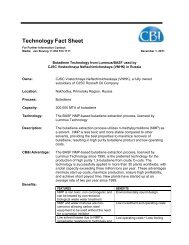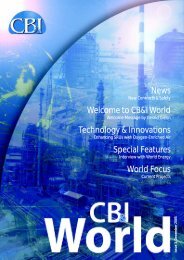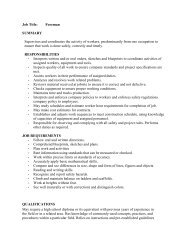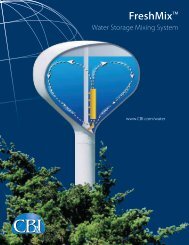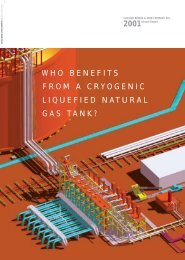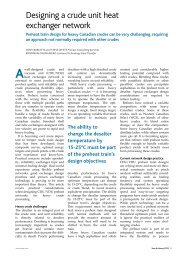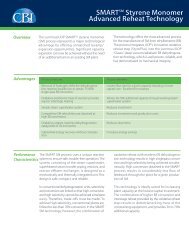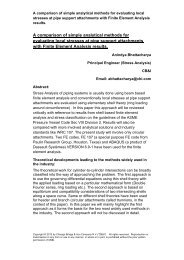Butadiene Extraction Technology - CB&I
Butadiene Extraction Technology - CB&I
Butadiene Extraction Technology - CB&I
Create successful ePaper yourself
Turn your PDF publications into a flip-book with our unique Google optimized e-Paper software.
<strong>Butadiene</strong> <strong>Extraction</strong> <strong>Technology</strong><br />
Overview<br />
The BASF NMP-based butadiene extraction process,<br />
licensed by Lummus <strong>Technology</strong> since 1990, is the<br />
preferred technology for the production of high<br />
purity 1,3-butadiene from crude C4 cuts. The<br />
technology is successfully applied in more than 30<br />
plants worldwide, with a total capacity exceeding<br />
three million tons per year.<br />
The NMP-based butadiene process uses n-methylpyrrolidone<br />
(NMP) as solvent. Unlike the other<br />
solvents used for butadiene extraction, the aqueous<br />
mixtures of NMP are not corrosive, thereby allowing<br />
the use of carbon steel as construction material<br />
without the addition of corrosion inhibitors. This<br />
process is particularly suitable for C4 streams from<br />
high severity cracking where the acetylene levels<br />
may be high (>3%). It produces a 1,3-butadiene<br />
product of 99.7 wt% purity while recovering more<br />
than 99% of the 1,3-butadiene contained in the<br />
feed. It also produces a raffinate-1 product that<br />
consists of a mixture of butanes and butenes with a<br />
butadiene content as low as 40 ppm wt.<br />
Advantages<br />
Process Features<br />
NMP is non toxic, non carcinogenic and can be<br />
treated by conventional biological waste water<br />
treatment<br />
NMP and water mixtures are non-corrosive<br />
allowing carbon steel equipment to be used<br />
without the need for a corrosion inhibitor<br />
Low solvent losses due to NMP’s remarkable<br />
resistance to hydrolysis and thermal decomposition<br />
as well as its high boiling point<br />
High yield (>99%) as well as high purity (>99.7%),<br />
regardless of the feed concentration<br />
Low energy consumption due to an efficient heat<br />
recovery system and optimal process design<br />
Operating periods exceeding four years without<br />
cleaning due to effective fouling inhibitor system<br />
Process Benefits<br />
Environmentally sound design<br />
Low investment and operating costs<br />
Low operating costs • Less fouling<br />
High value product<br />
Low operating costs<br />
Longer on stream time • Low maintenance costs<br />
Performance<br />
Characteristics<br />
Feed<br />
Feedstock Composition (typical) wt%<br />
1,3-<strong>Butadiene</strong> 40-55<br />
Butanes
<strong>Butadiene</strong> <strong>Extraction</strong> <strong>Technology</strong><br />
Block Flow<br />
Diagram<br />
Raffinate-1<br />
Propyne<br />
C 4 Feed<br />
<strong>Extraction</strong><br />
Distillation<br />
Crude <strong>Butadiene</strong><br />
Distillation<br />
1,3-<strong>Butadiene</strong><br />
C 4 Vapor<br />
1,2-<strong>Butadiene</strong><br />
Rich Solvent<br />
Lean Solvent<br />
Solvent<br />
Degassing<br />
C 4 Acetylenes<br />
Process<br />
Description<br />
A typical butadiene extraction plant consists of<br />
four basic process sections: extractive distillation,<br />
conventional distillation, solvent degassing, and<br />
solvent regeneration.<br />
The C4 feed is sent to the extractive distillation<br />
section where it is vaporized and separated using<br />
three extractive distillation columns. The overhead<br />
product from the first column consists of a mixture<br />
of butenes and butanes and is designated as<br />
raffinate-1. The overhead from the third column is<br />
a crude butadiene product that is sent to the<br />
conventional distillation system for further purification.<br />
Rich solvent is removed from the bottom of<br />
the second column and sent to the solvent degassing<br />
system.<br />
Crude butadiene is fed to the propyne column,<br />
which is the first of two columns in the conventional<br />
distillation section. Propyne is removed as<br />
overhead from this column and the bottoms is<br />
sent to the butadiene column. The butadiene<br />
product is withdrawn from the top of this column<br />
and the C5s as well as the 1,2-butadiene are rejected<br />
in the bottoms.<br />
The rich solvent from the extractive distillation<br />
section is fed to the solvent degassing section. The<br />
solvent is stripped free of C4s in the degassing<br />
column and recycled to the extractive distillation<br />
section. C4 acetylenes are removed as a side stream<br />
and can be hydrogenated, used as fuel gas or as<br />
cracker feed, or burned in a flare system. The vapor<br />
leaving the degassing column is cooled in a<br />
separate cooling column or heat exchanger,<br />
compressed, and sent back to the extractive<br />
distillation section. A sophisticated heat recovery<br />
system utilizes most of the sensible heat of the<br />
solvent, resulting in extremely low energy<br />
consumption.<br />
A small solvent stream is continuously fed to the<br />
NMP regeneration section. The solvent is heated<br />
with steam under vacuum conditions in a regeneration<br />
vessel. Vaporized NMP is condensed and<br />
recycled to the extractive distillation section. The<br />
remaining residue is usually incinerated.<br />
www.CBI.com/lummus-technology<br />
Only employees, agents, or representatives authorized under and pursuant to written agreement<br />
with CB&I are authorized to distribute this brochure to an actual or potential client of CB&I.<br />
©Copyright 2012 by Chicago Bridge & Iron Company. All rights reserved.



